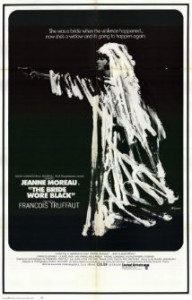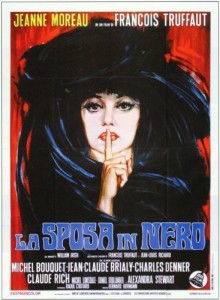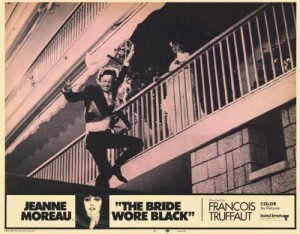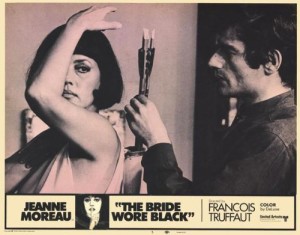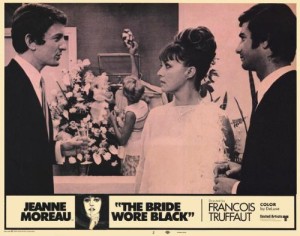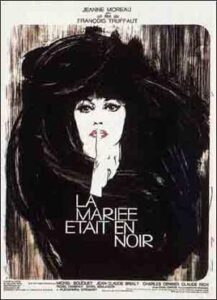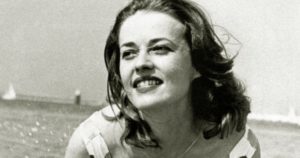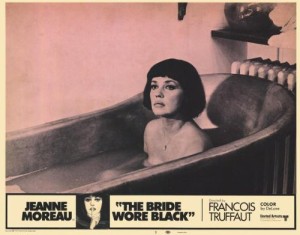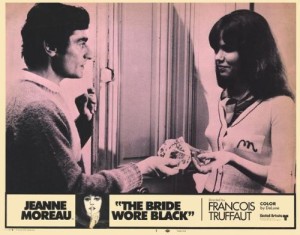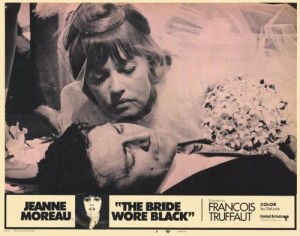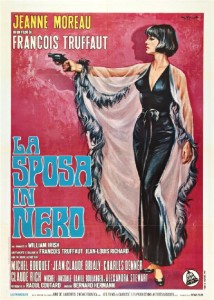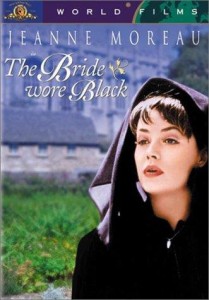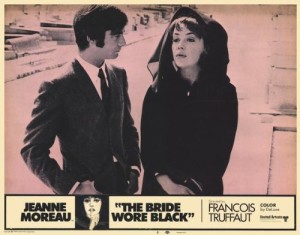The Bride Wore Black [La mariée était en noir] **** (1967, Jeanne Moreau, Jean-Claude Brialy, Michel Bouquet, Charles Denner, Claude Rich, Michel Lonsdale, Daniel Boulanger) – Classic Movie Review 2,588
François Truffaut’s 1968 salute to Alfred Hitchcock, the French thriller film The Bride Wore Black, is a richly enjoyable, quirky entertainment. Jeanne Moreau is on great form as a widow who sets out to kill five men who shot her groom dead on her wedding day.
Co-writer/director François Truffaut’s 1968 salute to his hero and mentor Alfred Hitchcock, the French revenge thriller film The Bride Wore Black [La mariée était en noir], is thoroughly enjoyable as a rich and idiosyncratic entertainment.
A commanding Jeanne Moreau on great Joan Crawford/ Bette Davis-style vengeance form in William Irish’s tale of Julie Kohler, a deranged widow who sets out to bump off the five men (Michel Bouquet, Charles Denner, Claude Rich, Michel Lonsdale, Daniel Boulanger) who accidentally shot and killed her groom (Serge Rousseau) on her wedding day. Julie only wears white, black or a mix of them, in a colour film.
Truffaut constructs the script Hitchcock-style by avoiding the simplistic (or satisfying, depending on viewpoint) idea of making a whodunit and giving the solution to the mystery early on (unlike the novel). He also employs Hitch’s regular trusted composer Bernard Herrmann to compose the score, and William Irish is the pen name of Cornell Woolrich, source author of Hitchcock’s 1954 movie success Rear Window. So, yes, Truffaut mixes the French New Wave with old Hollywood, and rather well too.
A flashback reveals that Julie’s husband was killed by a rifle shot fired by Delvaux (Daniel Boulanger), a member of a hunting club group that also included Bliss (Claude Rich), Coral (Michel Bouquet), Morane (Michel Lonsdale) and Fergus (Charles Denner), who were horsing around with a loaded rifle in an upper room across the street from the wedding church when it went off and shot the groom on the steps of church. They then went their separate ways, fast, vowing not to meet up and never to reveal their involvement in the groom’s death.
Truffaut said: ‘One thing intrigued me, to make a film without a single love scene. The origins of the film are my admiration for William Irish, my desire to make another film with Jeanne Moreau and my wanting to try the experiment of filming a super-dramatic story with extreme situations but realistic details.’ So, no mention of Hitchcock there, then.
Also in the cast are Jean-Claude Brialy, Christophe Bruno, Alexandra Stewart, Jacques Robiolles, Luce Fabiole and Sylvine Delannoy.
Truffaut won the Edgar Allan Poe Mystery Writers of America award for his screenplay (written with Jean-Louis Richard). The film was nominated for a Golden Globe Award for Best Foreign Language Film and was a financial success.
But it faced hostile attacks by French critics on release, and Truffaut later said he no longer liked the film, and that the critics were right. In 1983 Truffaut named this film when was asked which of his films he would change if he could, saying the emotional tone of many scenes came out wrong. Truffaut and his cinematographer Raoul Coutard had multiple day-long arguments, and the actors were directed by Jeanne Moreau in many scenes. Coutard, who had worked with Truffaut on five previous films, shoots in colour, following Truffaut’s 1966 film Fahrenheit 451, shot in England in colour by cinematographer Nicolas Roeg.
The film is undoubtedly a style object, with a glorious Sixties gloss, and also an homage to Moreau, gorgeously made up and gorgeously gowned. She looks older, very Bette Davis with the saucer eyes and turned down mouth, but absolutely stunning, at her best in the artist’s model sequence, dressed as the huntress Diana with bow and arrow. Truffaut stands in awe of Moreau.
What the film is not is a thriller. Truffaut has chucked that idea away by revealing the mystery early on. Instead, it is a series of vignettes, snapshots into the lives of the five killers. OK, only one of them actually killed the groom, but they are all guilty by implication. And Julie Kohler is not going to stop till they are all dead. As for her, she feels she is dead already.
The emotional tone? Well, the posh actors give it a lot of emotion in the very little screen time they each have, all creating something quite memorable, and it is a tribute to them and their very considerable skills. Some of it is quite haunting. As usual, Truffaut is very good with actors. Michel Bouquet, Michel Lonsdale and Charles Denner are quite tremendous, giving detailed, intimate performances that really count, certainly able to hold their own with the commanding Moreau.
Bernard Herrmann’s score is superb, and so is Raoul Coutard’s cinematography. Truffaut relies on them so much, as well as the actors, for his film’s power and effect.
The costumes are by Pierre Cardin. They are dazzlingly, eye-catchingly beautiful. Something else Truffaut relies on so much. It’s like he has assembled the best talent available, and let them get on with it. Why then the multiple day-long arguments with Raoul Coutard?
And why couldn’t we have a straight thriller? As with Shoot the Pianist, Truffaut says he has made the film out of his admiration for the original author. but each time his film is a horse of an entirely different colour. Fine, he doesn’t want to film the novel, but it’s kind of a shame that he won’t come up with a thriller. Nevertheless, the film is most amusing and satisfying, and weirdly involving for something quite so artificial.
The cast are Jeanne Moreau as Julie Kohler, Michel Bouquet as Coral, Jean-Claude Brialy as Corey, Charles Denner as Fergus, Claude Rich as Bliss, Michel Lonsdale as Clément Morane, Daniel Boulanger as Delvaux, Serge Rousseau as David, Alexandra Stewart as Mlle Becker, Christophe Bruno as Cookie Morane, Jacques Robiolles, Luce Fabiole and Sylvine Delannoy.
RIP legendary Jeanne Moreau (23 January 1928 – 31 July 2017).
© Derek Winnert 2015 Classic Movie Review 2,588
Check out more reviews on http://derekwinnert.com

